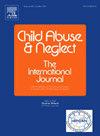18至24岁伊朗人网瘾患病率和精神病理机制的性别差异:一项全国性研究
IF 3.4
2区 心理学
Q1 FAMILY STUDIES
引用次数: 0
摘要
技术的快速发展给互动、学习和娱乐带来了革命性的变化,但也导致了网络成瘾,其特征是过度使用网络会造成损害或痛苦。目的:本研究探讨伊朗青少年网瘾患病率、危险因素和临床方面的性别差异,强调文化和社会影响。方法将全国年龄在18 ~ 24岁的3149人分为网络成瘾组(n = 1040)和非网络成瘾组(n = 2109)。被试完成童年创伤问卷-28、分离体验量表(DES)、情绪调节困难量表(DERS)和网络成瘾测试(IAT)。数据分析采用SPSS软件26版,显著性水平设为<;0.05。结果网络成瘾总体患病率为33%,其中男性(63.3%)高于女性(36.7%)(χ2 = 13.28, p = 0.001)。在男性中,网络成瘾的严重程度与情绪虐待(β = 0.20, p小于0.001),DES (β = 0.39, p小于0.001)和DERS (β = 0.16, p小于0.001)(F(3,654) = 89.85, p小于0.001,R2 = 0.29)显著相关;而在女性中,它与情感虐待(β = 0.18, p小于0.001)和分离经历(β = 0.16, p小于0.001)(F(2,379) = 13.70, p小于0.001,R2 = 0.06)有关。DES在两性中部分介导了情绪虐待与IAT分数之间的关系,而DERS仅在男性中起作用。结论网络成瘾是早期情绪虐待的一种适应不良的应对机制,需要采取预防措施和情绪调节干预措施。未来的研究应考虑纵向效应和文化影响。本文章由计算机程序翻译,如有差异,请以英文原文为准。
Gender differences in the prevalence and psychopathological mechanisms of internet addiction among Iranians aged 18 to 24: A nationwide study
Background
The rapid advancement of technology has revolutionized interaction, learning, and entertainment but also led to Internet addiction, characterized by excessive internet use causing impairment or distress.
Objective
The study explores gender differences in prevalence, risk factors, and clinical aspects of Internet addiction among Iranian youth, highlighting cultural and societal influences.
Methods
A nationwide sample of 3149 individuals aged 18 to 24 was categorized into two groups: those with Internet addiction (n = 1040) and those without (n = 2109). Participants completed the Childhood Trauma Questionnaire-28, Dissociative Experiences Scale (DES), Difficulties in Emotion Regulation Scale (DERS), and Internet Addiction Test (IAT). Data analyses were conducted using SPSS software version 26, with a significance level set at <0.05.
Results
Overall prevalence of Internet addiction was found to be 33 %, with a higher incidence in males (63.3 %) compared to females (36.7 %) (χ2 = 13.28, p = 0.001). In men, the severity of Internet addiction was significantly linked to emotional abuse (β = 0.20, p˂0.001), DES (β = 0.39, p˂0.001), and DERS (β = 0.16, p˂0.001) (F(3, 654) = 89.85, p˂0.001, R2 = 0.29); while in women, it was associated with emotional abuse (β = 0.18, p˂0.001) and dissociative experiences (β = 0.16, p˂0.001) (F(2, 379) = 13.70, p˂0.001, R2 = 0.06). The DES partially mediated the relationship between emotional abuse and IAT scores in both genders, whereas DERS only did so in males.
Conclusions
The study suggests Internet addiction as a maladaptive coping mechanism for early emotional abuse, highlighting the need for prevention programs and emotion regulation interventions. Future research should consider longitudinal effects and cultural influences.
求助全文
通过发布文献求助,成功后即可免费获取论文全文。
去求助
来源期刊

Child Abuse & Neglect
Multiple-
CiteScore
7.40
自引率
10.40%
发文量
397
期刊介绍:
Official Publication of the International Society for Prevention of Child Abuse and Neglect. Child Abuse & Neglect The International Journal, provides an international, multidisciplinary forum on all aspects of child abuse and neglect, with special emphasis on prevention and treatment; the scope extends further to all those aspects of life which either favor or hinder child development. While contributions will primarily be from the fields of psychology, psychiatry, social work, medicine, nursing, law enforcement, legislature, education, and anthropology, the Journal encourages the concerned lay individual and child-oriented advocate organizations to contribute.
 求助内容:
求助内容: 应助结果提醒方式:
应助结果提醒方式:


